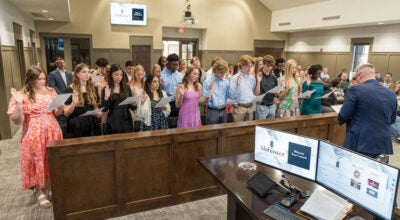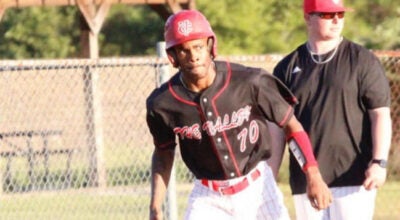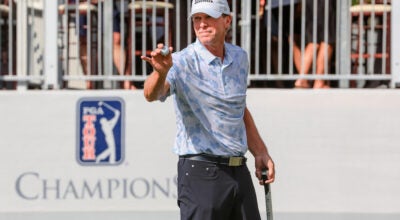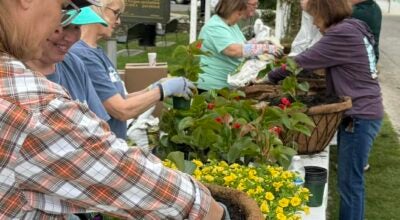UPDATED: Truck driver gives graphic depiction of discovering Davis’ body
Published 6:24 pm Friday, May 6, 2011
By BRAD GASKINS / Staff Writer
COLUMBIANA – The first person to discover the body of slain Pelham police officer Philip Davis gave jurors a graphic depiction of the scene May 6 during the first day of testimony in Bart Johnson’s capital murder trial.
The state called seven witnesses throughout the day, including a DNA expert.
Roger Wilder, a truck driver who discovered Davis’ body halfway in the right lane of Interstate 65 after Davis was shot Dec. 3, 2009 at 11:57 p.m., was the state’s first witness.
Wilder, of Rockford, described himself as a professional truck driver for nearly a decade at the time he came up on Davis’ body lying on the pavement. He said he called 911 and was told to check for a pulse. He said there was a pulse but no movement.
Wilder said he “heard a gurgling sound like he (Davis) was trying to speak.”
Shortly after midnight on Dec. 4, 2009, Pelham Police Sgt. Steven Carter, who testified next, said heard a call go out over police radio. “Fox Trot 58, Code 10,” the dispatcher said. Carter testified that he wasn’t alarmed when Davis failed to respond that all was well, but ran out of the building and drove towards Davis’ last known location when Davis failed to answer a second time.
Carter said that another officer was performing CPR on Davis when he arrived at the scene.
Davis had no pulse, a sobbing Carter testified, adding that Davis’ “eyes were open and fixed” and blood from his head had run across both northbound lanes.
The testimonies came after jurors heard opening statements in the capital murder trial.
Johnson has pleaded not guilty by reason of mental disease or defect in the shooting death of Davis during what began as a routine traffic stop on Interstate 65.
District Attorney Robert Owens described Johnson, a pharmacist, as a “go-to guy” for Fred’s Pharmacy. In the few days before he allegedly shot Davis, Johnson had been sent by Fred’s to Gulf Shores to help open a new “flagship” store, Owens said during his opening statement.
After staying there for several days in a hotel, Johnson left to return to his Kimberly home sometime between 8 to 8:30 p.m. on December 3, 2009. At 11:23 p.m. he was in the Clanton area, as indicated by a “ping” from his mobile phone picked up by a cell tower in the area, Owens said.
At 11:57 p.m., Owens said, Johnson put a Glock .40-caliber pistol to Davis’ face and pulled the trigger. Johnson then fled, ditched his car and attempted to steal another car before being picked up by his brother – a Trussville police officer – and eventually being caught at a roadblock in Hoover, Owens told jurors.
Johnson’s defense attorney, Charles Salvagio, in an opening statement, didn’t dispute most of those statements. Instead, Salvagio asked a question central to the defense’s case: why?
“Why,” Salvagio asked, “would a man who had come so far in the world” and was on his way to see his wife and two kids suddenly decide to shoot a police officer?
“We now know why,” Salvagio answered. It was, he said, a “perfect storm” of sleep deprivation and effects of migraine medication. Johnson, he said, had suffered from at least two migraines a week since he was 17.
Salvagio said experts would later explain Johnson’s mental illness diagnosis. He said Johnson stayed in a “noisy hotel” while in Gulf Shores and never should have started driving home that night, but did so because he was excited to see his family. Salvagio said Johnson had taken a gun with him to Gulf Shores for protection.
The state alleges Johnson drove away from the scene of the shooting in his Acura, which had a specialized license plate reading: JCREW1. That, Owens said, stood for “Johnson Crew One,” not J.Crew the clothing company.
Testimony resumed after Friday’s lunch break, and more details emerged.
In the early morning hours of December 4, Loletha Story was making a cup of coffee in the kitchen of her Inglenook home. She told jurors she heard a squealing noise, looked outside and saw a white man get out of a car and walk down the sidewalk.
The man, whom she could not identify as Johnson, came into her yard and tried to open the door of her daughter’s locked car. When she opened a house door and verbally confronted the man, he motioned for her to go back inside, Story testified.
She called police with the squealing car’s plate – JCREW1. Police told her the man driving it was a suspect in an unspecified incident, and told her to lock her door and stay inside.
She looked out the window, she testified, and saw the man emerge and get into the passenger’s side of a gray Toyota Tundra truck.
Trussville police Sgt. Jason Grant testified that a BOLO alert for the Acura with JCREW1 tags was issued to Trussville police at 12:40 a.m. on December 4. Grant said a Trussville officer ran the tag, saw the registered address and realized it belonged to Bart Johnson, brother of Trussville police officer Bill Johnson.
Officer Bill Johnson was instructed three separate times to respond to Bart Johnson’s Kimberly address but never did, Grant testified.
At 1:06 a.m., Grant testified, he called Officer Johnson, who was known to drive a gray Toyota Tundra, and was told Officer Johnson was travelling south on Interstate 65.
At 1:30 a.m., Grant testified, a call went out over county frequencies that the Acura had been found, and that a gray Toyota Tundra had been spotted near Loletha Story’s house in Inglenook.
Grant called Officer Johnson back and told him there was a BOLO out for the gray Toyota Tundra he was driving, Grant testified.
Within a few minutes, testimony from other witnesses indicated, the truck was stopped at Interstate 65 and Highway 31.
Hoover Police officer Eddie Morrissette testified that he arrived on the scene as other Hoover officers arrested Bart Johnson and Officer Bill Johnson at gunpoint.
Bart Johnson eventually told Morrissette, “I’m the one you’re looking for,” Morrissette testified.
The Johnson brothers were placed in separate police cars and transported to the Hoover jail, testimony indicated.
Prosecutors asked Morrissette, who said he had worked “hundreds” of DUI and illegal drug stops, if Bart Johnson appeared to be under the influence of either.
Bart Johnson “complied completely” and “didn’t appear to be under the influence of alcohol or drugs,” Morrissette testified.
Under cross-examination from the defense, Morrissette was asked if he knew how soon Johnson went to sleep after being placed in a cell. Morrissette said he could not recall.
A Hoover crime scene investigator then testified that he opened the glove box of the Toyota Tundra and found a Glock .40-caliber pistol.
DNA expert Carl Mauterer with the Alabama Department of Forensic Sciences testified that blood samples from the Acura’s driver’s side door and inside console matched DNA samples from Davis, with a high degree of confidence. Blood found on the gun also matched Davis’, Mauterer testified.
Testimony resumes Monday at 9 a.m.









